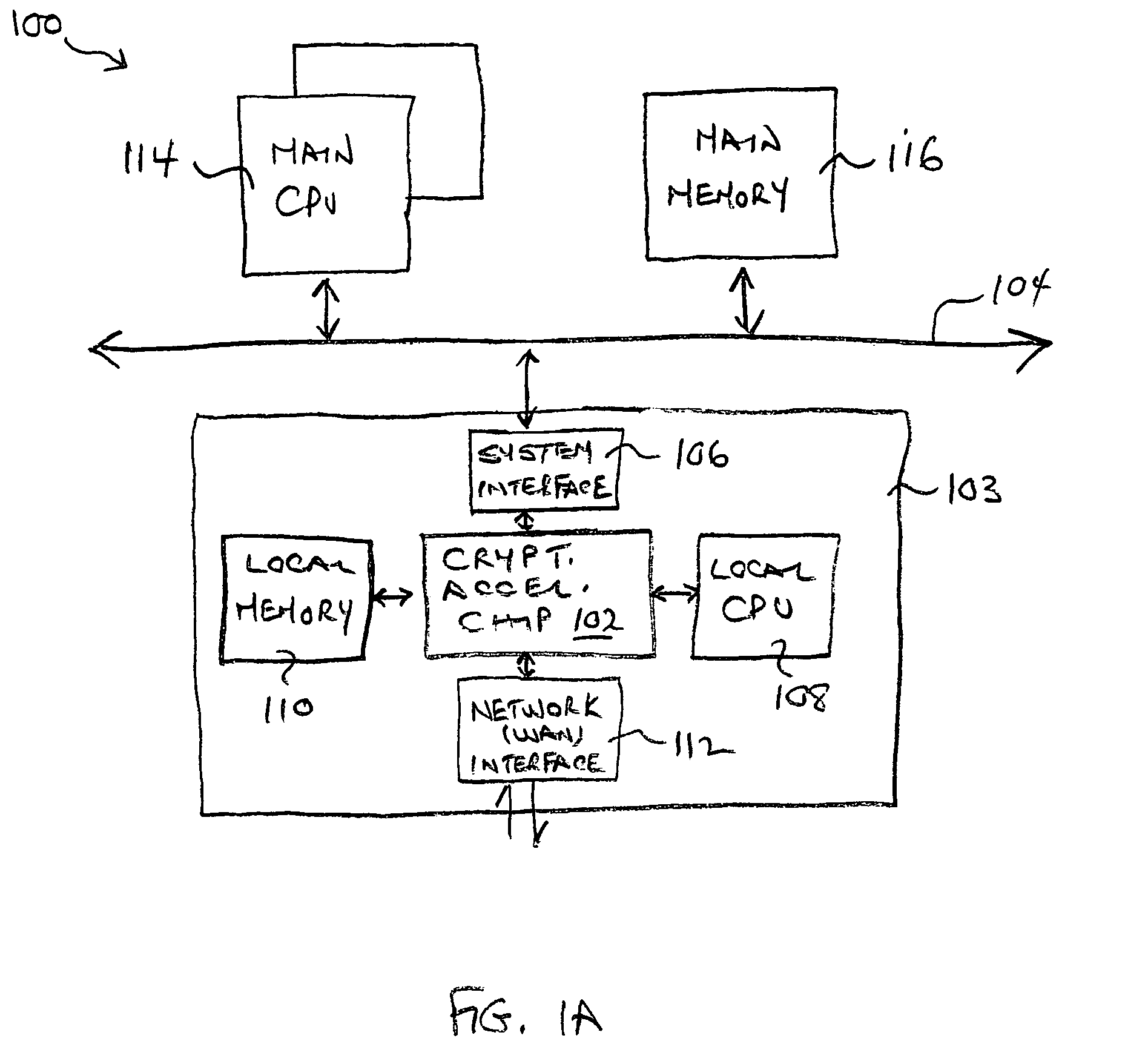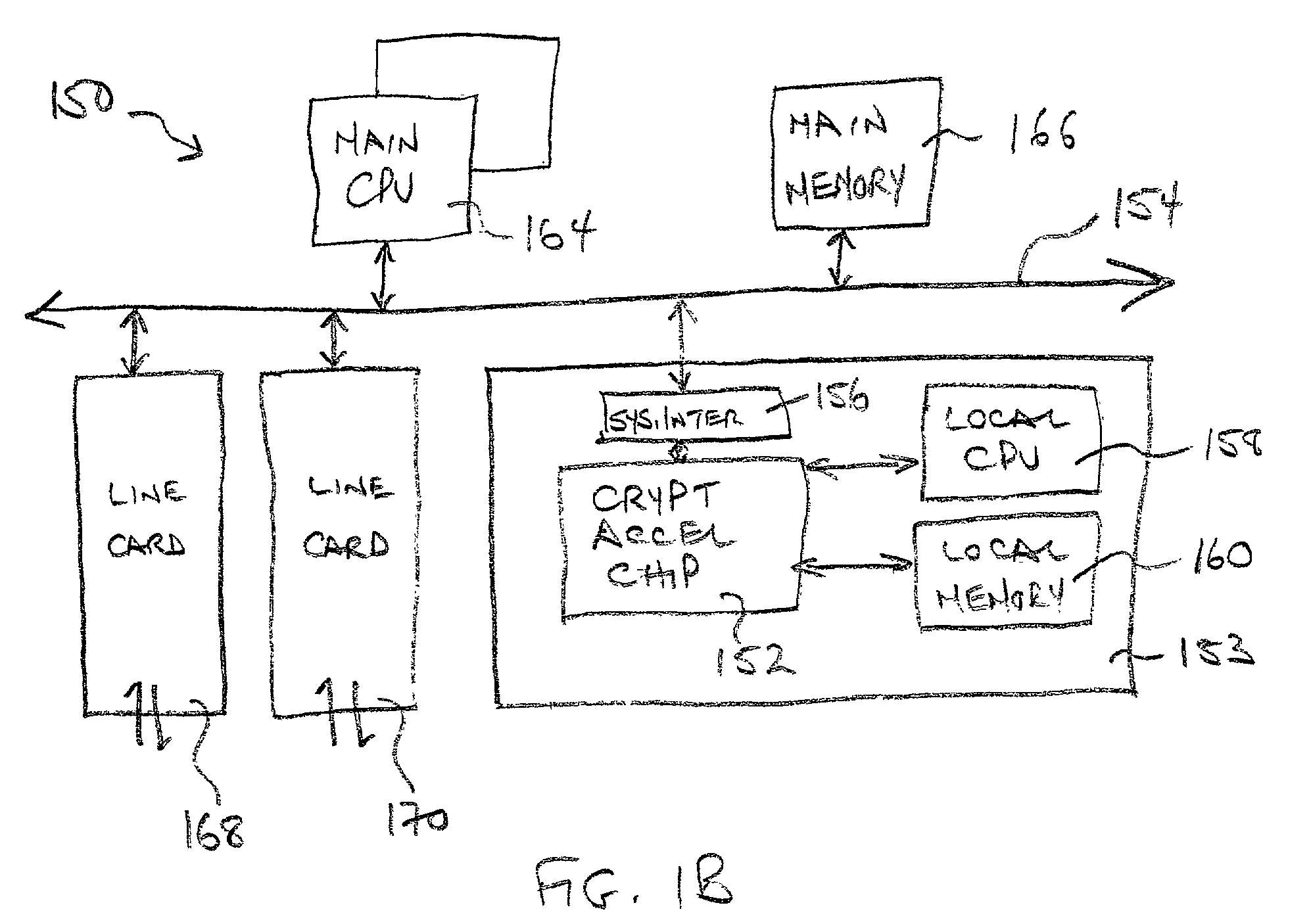Distributed processing in a cryptography acceleration chip
a cryptography acceleration and chip technology, applied in the field of cryptography, can solve the problems of inability to meet the needs of large external attached memory in order to operate, most expensive type of memory, and inability to meet the needs of many applications in terms of cost versus performance, so as to achieve efficient processing of encryption/decryption of data packets, improve performance, and significant performance improvement
- Summary
- Abstract
- Description
- Claims
- Application Information
AI Technical Summary
Benefits of technology
Problems solved by technology
Method used
Image
Examples
example 1
Security Association Prefetch Buffer
[0095]The purpose of the SA buffer prefetch unit is to hold up to eight Security Association Auxiliary structures, two per active processing engine. This corresponds to up to two packet processing requests per engine, required to support the double-buffered nature of each engine. The double buffered engine design enables header prefetch, thus hiding DRAM latency from the processing units. The structures are accessed by SA index, as generated by the packet classifier.
[0096]Partial contents for the SA Auxiliary structure are as shown in the following C code fragment:
[0097]
typedef struct SATAux_struct {u32 byteCount; / * Total payload bytes processed via * / / * this entry (larger of crypto or auth bytes) * / u64 expiry; / * Expiry time or #bytes for this * / / * entry (checked per use) * / u32 packetCount; / * Stats - # packets processed via this entry * / struct SATAux_struct *next; / * Next IPSec Security Association for SA * / / * bundles * / u32 seqNoHi; / * Anti...
example 2
Distributor Microcode Overview
[0099]In one implementation of the present invention, the distributor unit has a micro-engine large register file (128 entries by 32-bits), good microcode RAM size (128 entries by 96-bits), and a simple three stage pipeline design that is visible to the instruction set via register read delay slots and conditional branch delay slots. Microcode RAM is downloaded from the system port at power-up time, and is authenticated in order to achieve FIPS 140-1 compliance. In order to ensure immediate micro-code response to hardware events, the micro-engine is started by an event-driven mechanism. A hardware prioritization unit automatically vectors the micro-engine to the service routing for the next top-priority outstanding event; packet retiring has priority over issue.
[0100]
Packet Issue Microcode: / / / / SA Buffer entry has been pre-fetched and is on-chip / / Packet length is available on-chip / / test drop / pass flags; if set special case processing;test lifetime; bre...
example 3
Advanced Classification Engine (ACE)
[0104]In one specific implementation of the present invention, a classification engine (referred to as the Advanced Classification Engine (ACE)) provides an innovative solution to the difficult problem of implementing the entire set of complex IPSec specified Security Association Database and Security Policy Database rules in hardware. The IETF IPSec protocol provides packet classification via wildcard rules, overlapping rules and conflict resolution via total rule ordering. The challenge solved by ACE is to implement this functionality in wirespeed hardware.
[0105]The Advanced Classification Engine of a chip in accordance with the present invention handles per-packet lookup based on header contents. This information then determines the type of IPSec processing that will be implemented for each packet. In effect, ACE functions as a complete hardware IPSec Security Association Database lookup engine. ACE supports full IPSec Security Association look...
PUM
 Login to View More
Login to View More Abstract
Description
Claims
Application Information
 Login to View More
Login to View More - R&D
- Intellectual Property
- Life Sciences
- Materials
- Tech Scout
- Unparalleled Data Quality
- Higher Quality Content
- 60% Fewer Hallucinations
Browse by: Latest US Patents, China's latest patents, Technical Efficacy Thesaurus, Application Domain, Technology Topic, Popular Technical Reports.
© 2025 PatSnap. All rights reserved.Legal|Privacy policy|Modern Slavery Act Transparency Statement|Sitemap|About US| Contact US: help@patsnap.com



